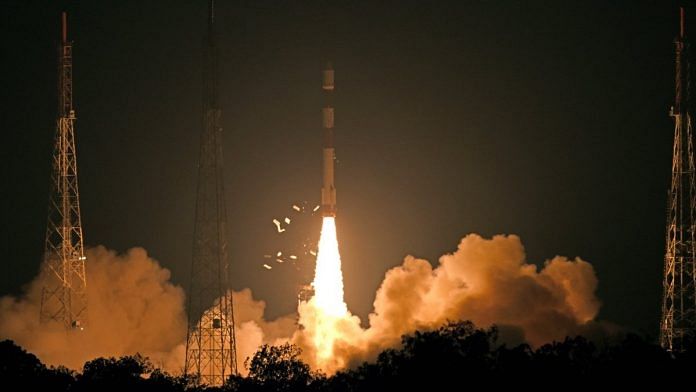Bengaluru: Amid much talk about ‘clouds and radar’ in the last few weeks, the Indian Space Research Organisation (ISRO) Wednesday launched a cloud-penetrating spy satellite to image and observe Earth.
The RISAT-2B satellite, India’s second functioning radar eye, will offer a host of services to India’s industries, and for other strategic purposes, like surveillance and military reconnaissance.
?? #ISROMissions ??#PSLVC46 successfully injects #RISAT2B into Low Earth Orbit.
Here's the view of #RISAT2B separation captured by our onboard camera
Our updates will continue. pic.twitter.com/WUTBdNH2XJ
— ISRO (@isro) May 22, 2019
Unlike most other Earth observation satellites launched by ISRO, RISAT-2B isn’t an optical satellite and, thus, can penetrate through extreme weather and clouds.
The launch of the new satellite comes two years after the RISAT-1 stopped functioning and India was left with one radar satellite — the RISAT-2, which was launched after the Mumbai 2008 terrorist attacks.
With ISRO’s launch of the new spy satellite, ThePrint takes a look at the functioning and use of RISAT-2B, and how it will be affected by clouds.
Also read: There’s a mysterious Indian spy aboard the PSLV that ISRO just launched into space
How the new satellite works
The RISAT-2B uses synthetic aperture radar, which is used to create 2-dimensional images or 3-dimensional reconstructions of landscapes or objects.
This is done by transmitting a series of radio waves, which reach the target and bounce off it, back to the satellite. Since the satellite is moving in space, the transmitted pulses hit the target at different angles. All the reflected signals (called ‘echoes’) from the different antenna positions are then combined to form a high resolution reconstruction.
Such imaging and reconstruction finds a wide variety of applications, including geology, change in terrain; sub-surface imaging, as radar can often penetrate the ground; glaciology, to measure ice thickness and growth; volcano and earthquake monitoring; deforestation; crop growth and yield; monitoring oil spills; recording growth of civil infrastructure; and military surveillance.
In the case of military recon, if a target is moving, the echoes reflected back are shifted in frequency, much like the Doppler Effect. This enables the recipient to infer details about the speed and direction of motion of the target.
Military radar satellites today can have up to 10cm resolution, which means they can resolve two separate targets placed 10cm apart. However, RISAT-2B’s resolution hasn’t been revealed.
The RISAT-2 has been used regularly to track activities beyond the border and to outmanoeuvre infiltration bids. RISAT-2B is expected to enable better and continuous support for the same objectives.
Can it penetrate clouds?
The launch of ISRO’s new satellite comes close on the heels of the Balakot air strikes and Prime Minister Narendra Modi’s subsequent controversial comments about how, at the time, he thought clouds offered protection against radar.
The RISAT-2B is an all-weather satellite — it can function optimally and efficiently in all kinds of weather. This includes penetration through heavy clouds as well.
The RISAT-2B will operate on the X-band of frequencies in the microwave radio region of the electromagnetic spectrum. Operating on this band aids in the transmission of signals through extreme weather.
The radar technology has improved and evolved over the past century, since it was first used in battle during World War II. While experts are divided on their opinion about the extent to which radio signals are attenuated or weakened by bad weather, it is no secret that radar is used widely for military applications, including tracking vehicles like aircraft and ships, precisely due to their ability to penetrate through most objects in their operating frequency, including clouds.
Also read: ISRO’s women scientists who busted ‘Mars is for men’ and other such myths with MOM



